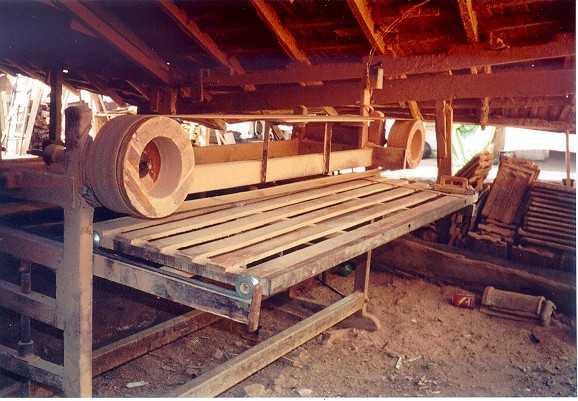|
|
|
|
While visiting our family in Brazil, we took the opportunity to tour three woodworking shops. Shops in Brazil, like here, range from small one man operations to large 20+ man operations. The three shops we visited are local shops, located in the middle of neighborhoods. Larger shops can be found in the larger industrial centers.
I found the following very interesting:
The first shop we visited was a one man shop located right around the corner from my Mother-In-Law's house. The shop had a variety of power tools including a "shop-made" table saw, band saw, and stroke sander. He also had a shaper, not too different from what we use in the states. He had mounted a 10" circular saw blade in the shaper which looked incredibly dangerous. No guards, no protection, yikes!
His bandsaw, at least 90% made of wood, was huge. Like most of his tools, it did not sit flat on the floor and did not appear to be setup square. That said, it appears to cut well and square, meaning the owness for quality cuts is on the operator not the saw.
His table saw had a wooden table and fence. The fence clamped to the table with two bolts, much like a shaper fence or some router fences. No measuring tapes, etc. Huge motor, looked like it could produce 20 HP!
His primary product is raised panel entry doors. They were absolutely beautiful, consisting of 20+ small raised panels, mortise and tenon frames, mitered moldings, etc. He produces 2 doors a day. The shop had dirt floors, chickens under foot, and was open on several sides. Consequently, he contracts out for most of his finishing.
| Shop-Made Stroke Sander |

|
The second shop we visited was large and again close to home base. It consisted of three separate buildings. The larger building is used for all of the milling and assembly operations for their casework. The second building is used to assemble and upholster sofas and chairs. The third building is used for finishing.
This shop has remarkably modern and high-cost machinery. Most of the machinery is industrial. The jointers, planer, table saws, stroke sander, and shapers were much larger and powerful than what we would buy for a small shop or home shop. The jointers were huge. The planer/thicknesser was Delta's largest. The Rockwell table saw had a cast iron sliding table with rails at least 20' long. They had three lathes. One was a high-tech copy lathe. Another looked alot like a high-end General lathe.
The shop does not use pnuematic tools, electric sanders, nailers, etc. All hand work was done, by hand.
We spent most of our time in the finishing shop. The finishing area was a large room approximately 15' x 15'. It had a single exhaust fan. It had a large finishing table with a shop-made carousel, kinda like a lazy suzan on steroids. They use a two part sanding sealer and varnish. If stain is desired, it is mixed with the clearcoat. A separate adjoining room is used for drying. Wooden drying racks are mounted to the walls.
Their finishing process is as follows:
The third shop (a small company named MACAM), primarily makes carved headboards, picture frames, and mirror frames. Carving is the company's primary calling card. They also do some contracted carving. The shop is basically a three walled enclosure with a corrugated steel roof and dirt floor. They had a small band saw, stroke sander, planer, jointer, table saw, shaper, horizontal bore, etc. Their equipment was professional, but not necessarily "industrial".
Their two carvers use mild stool cutting tools. They looked like file blanks sharpened and shaped for carving. They don't use grinders, Tormeks, or other hi-tech sharpening devices to sharpen their tools. Rather, one of the carvers showed me what appeared to be a rough rock. It was not a flat sharpening stone like we are used to. I was amazed! Most of the chisels had wooden handles. Both carvers we watched hammered way with wooden mallets, each cut chipping away relatively large amounts of material with each blow. Patterns are stored in a cardboard box and are traced onto the wooden blanks using carbon paper. The relief is left to the carver's talent.
Other workers manufacture the remaining components. They were busy cutting mortises, trimming tenons, sanding the carvings, and so forth. This shop had 8 to 10 employees.
MACAM sells complete beds with their elegantly carved headboards for approximately $30 in lots of 10, $60 for one! Marcelo is now in the U.S., building incredible pieces of furniture (1800's period furniture). Contact Marcelo Fonseca
| One of the Carvers |

|
| Marcelo Fonseca and another Carver (and part of my stomach-far left) |

|
| One of Several Headboard Styles (Took this picture in the Shop) |

|
| A Mirror/Picture Frame (Took this picture in Marcelo's Office) |

|
| Another Mirror/Picture Frame |

|
| Another Mirror/Picture Frame |

|
If you have any questions, E-Mail Me!